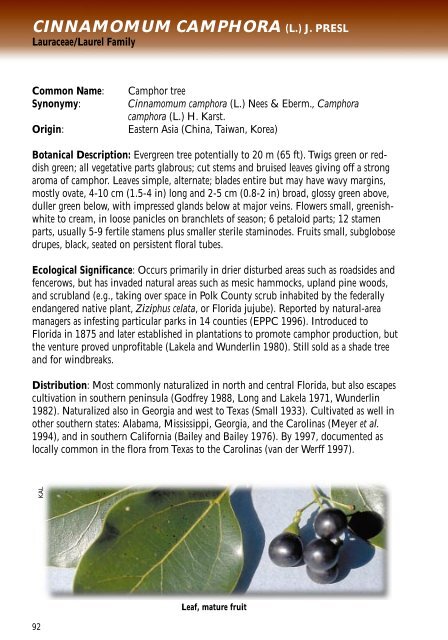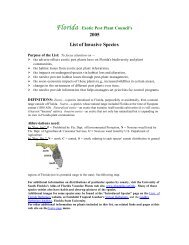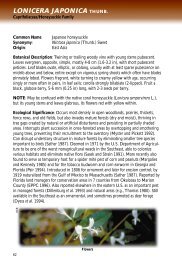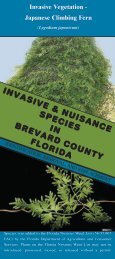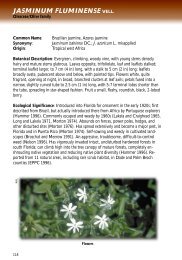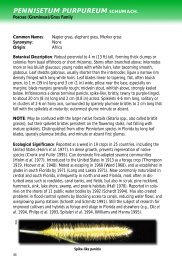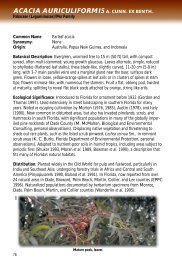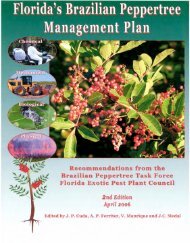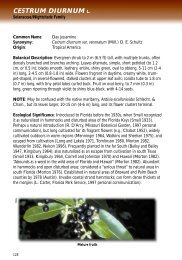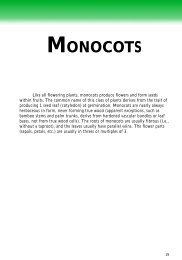DICOTS - Florida Exotic Pest Plant Council
DICOTS - Florida Exotic Pest Plant Council
DICOTS - Florida Exotic Pest Plant Council
You also want an ePaper? Increase the reach of your titles
YUMPU automatically turns print PDFs into web optimized ePapers that Google loves.
Cinnamomum camphora (L.) J. Presl<br />
Lauraceae/Laurel Family<br />
Common Name: Camphor tree<br />
Synonymy: Cinnamomum camphora (L.) Nees & Eberm., Camphora<br />
camphora (L.) H. Karst.<br />
Origin: Eastern Asia (China, Taiwan, Korea)<br />
Botanical Description: Evergreen tree potentially to 20 m (65 ft). Twigs green or reddish<br />
green; all vegetative parts glabrous; cut stems and bruised leaves giving off a strong<br />
aroma of camphor. Leaves simple, alternate; blades entire but may have wavy margins,<br />
mostly ovate, 4-10 cm (1.5-4 in) long and 2-5 cm (0.8-2 in) broad, glossy green above,<br />
duller green below, with impressed glands below at major veins. Flowers small, greenishwhite<br />
to cream, in loose panicles on branchlets of season; 6 petaloid parts; 12 stamen<br />
parts, usually 5-9 fertile stamens plus smaller sterile staminodes. Fruits small, subglobose<br />
drupes, black, seated on persistent floral tubes.<br />
Ecological Significance: Occurs primarily in drier disturbed areas such as roadsides and<br />
fencerows, but has invaded natural areas such as mesic hammocks, upland pine woods,<br />
and scrubland (e.g., taking over space in Polk County scrub inhabited by the federally<br />
endangered native plant, Ziziphus celata, or <strong>Florida</strong> jujube). Reported by natural-area<br />
managers as infesting particular parks in 14 counties (EPPC 1996). Introduced to<br />
<strong>Florida</strong> in 1875 and later established in plantations to promote camphor production, but<br />
the venture proved unprofitable (Lakela and Wunderlin 1980). Still sold as a shade tree<br />
and for windbreaks.<br />
Distribution: Most commonly naturalized in north and central <strong>Florida</strong>, but also escapes<br />
cultivation in southern peninsula (Godfrey 1988, Long and Lakela 1971, Wunderlin<br />
1982). Naturalized also in Georgia and west to Texas (Small 1933). Cultivated as well in<br />
other southern states: Alabama, Mississippi, Georgia, and the Carolinas (Meyer et al.<br />
1994), and in southern California (Bailey and Bailey 1976). By 1997, documented as<br />
locally common in the flora from Texas to the Carolinas (van der Werff 1997).<br />
KAL<br />
92<br />
Leaf, mature fruit


